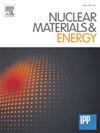Study on the annealing and three-point bending fracture behavior of single W fiber-reinforced W composites with multiple interfaces prepared by CVD
IF 2.7
2区 物理与天体物理
Q1 NUCLEAR SCIENCE & TECHNOLOGY
引用次数: 0
Abstract
The inherent brittleness of tungsten severely limits its application as plasma-facing materials (PFMs). Tungsten fiber (Wf) reinforced tungsten (W) composites (Wf/W) offer a promising toughening approach for tungsten. However, this toughening method faces significant challenges, such as how to optimize the interface strength and preventing damage to the fiber-reinforced structure. In this study, four types of interfaces (Y, Cr, Y2O3, and YSZ) were prepared using magnetron sputtering technology, followed by the fabrication of single Wf-reinforced W composites via chemical vapor deposition (CVD). The fracture behavior of the Wf/W composite before and after the annealing process was investigated through three-point bending tests. The results indicate that the interfaces including yttrium (Y), yttrium oxide (Y2O3), and yttria-stabilized zirconia (YSZ) all exhibit weak binding strength, leading to interface debonding during the three-point bending test and resulting in ductile fracture behavior for the composite. In contrast, the chromium (Cr) interface displays a high binding strength and lead to brittle fracture behavior for the composite. After annealing at 1000 °C, the binding strength of Y2O3 and YSZ interfaces increases, which causes the brittle fracture behavior of the composite. After annealing at 1600 °C, the Cr interface diffused into the Wf and caused the recrystallization of the Wf. The Y interface underwent melting and solidification, leading to a decrease of the binding strength. The interface strength ranks as follows: Cr > YSZ > Y2O3 > Y.
CVD制备多界面单W纤维增强W复合材料的退火及三点弯曲断裂行为研究
钨的固有脆性严重限制了其作为等离子体表面材料(pfm)的应用。钨纤维增强钨复合材料(Wf/W)是一种很有前途的增韧材料。然而,这种增韧方法面临着巨大的挑战,如如何优化界面强度和防止纤维增强结构的破坏。本研究采用磁控溅射技术制备了四种界面(Y、Cr、Y2O3和YSZ),然后通过化学气相沉积(CVD)制备了单W - f增强W复合材料。通过三点弯曲试验研究了Wf/W复合材料退火前后的断裂行为。结果表明:钇(Y)、氧化钇(Y2O3)和钇稳定氧化锆(YSZ)的界面均表现出较弱的结合强度,导致复合材料在三点弯曲试验中界面脱粘,呈现韧性断裂行为;相反,铬(Cr)界面表现出较高的结合强度,导致复合材料脆性断裂。在1000 ℃退火后,Y2O3和YSZ界面的结合强度增加,导致复合材料脆性断裂。在1600 ℃退火后,Cr界面扩散到Wf中,引起Wf再结晶。Y界面熔融凝固,导致结合强度降低。界面强度排序如下:Cr >; YSZ >; Y2O3 >; Y。
本文章由计算机程序翻译,如有差异,请以英文原文为准。
求助全文
约1分钟内获得全文
求助全文
来源期刊

Nuclear Materials and Energy
Materials Science-Materials Science (miscellaneous)
CiteScore
3.70
自引率
15.40%
发文量
175
审稿时长
20 weeks
期刊介绍:
The open-access journal Nuclear Materials and Energy is devoted to the growing field of research for material application in the production of nuclear energy. Nuclear Materials and Energy publishes original research articles of up to 6 pages in length.
 求助内容:
求助内容: 应助结果提醒方式:
应助结果提醒方式:


